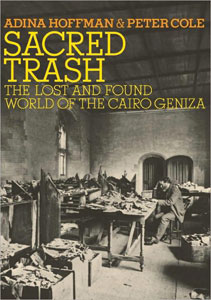“Sacred Trash: The Lost and Found World of the Cairo Geniza” by Adina Hoffman and Peter Cole (Schocken Books, 2011) $26.95 In 1896 when Cambridge scholar Rabbi Solomon Schechter, who later became the president of the Jewish Theological Seminary, was shown a fragment of a Hebrew manuscript purchased in Cairo, his world tilted on its axis. The fragment was the first known Hebrew copy of a second century apocryphal text known as Ecclesiasticus, included in the Greek Orthodox and Catholic Bibles, but not in the Jewish canon. This discovery sent Schechter to Egypt where he managed to purchase and carry away a significant portion of the Cairo Geniza.
In 1896 when Cambridge scholar Rabbi Solomon Schechter, who later became the president of the Jewish Theological Seminary, was shown a fragment of a Hebrew manuscript purchased in Cairo, his world tilted on its axis. The fragment was the first known Hebrew copy of a second century apocryphal text known as Ecclesiasticus, included in the Greek Orthodox and Catholic Bibles, but not in the Jewish canon. This discovery sent Schechter to Egypt where he managed to purchase and carry away a significant portion of the Cairo Geniza.
For those unfamiliar with the term geniza, it is a storage area, usually attached to a synagogue, in which damaged sacred texts are stored or buried. The discovery of the Cairo Geniza and the scholarly study of its contents restored to the Jewish people at least 1,000 years of lost history. The Cairo Geniza was a treasure trove, not just of damaged sacred texts, but also of lost poetry from the Jewish Golden Age of Spain, of history of the Jewish merchants who traded throughout the Mediterranean world and beyond, irrefutable proof of the existence of the mythical Kingdom of the Khazars, and even some Yiddish documents from the Middle Ages. One hundred twenty five years later, scholars are still piecing together fragments of history into a whole that astounds.
Poets Adina Hoffman and Peter Cole have written an exciting book that reads almost like a novel. In one chapter, they bring to life the development of secular Hebrew poetry in Medieval Spain. In another chapter, we meet the scholar S. D. Goitein whose monumental five-volume history of the Jews in the Medieval Mediterranean world is unmatched to this day. Another chapter explores palimpsests in which writers reused damaged parchments by writing over old texts. Then in the 20th century, scholars rediscovered what the original texts were.
As discovery follows discovery, readers not only are thrilled by the Geniza’s hidden treasures, but also develop an appreciation of their own genizas. What’s stored in your attic? Most of us tend to save our histories in trunks and cardboard boxes either in the basement or attic. After reading “Sacred Trash,” a reader develops a whole new appreciation for one’s trash — not to mention awe over the discoveries of the Cairo Geniza.
Andrea Kempf is a retired librarian who speaks throughout the community on various topics related to books and reading.


